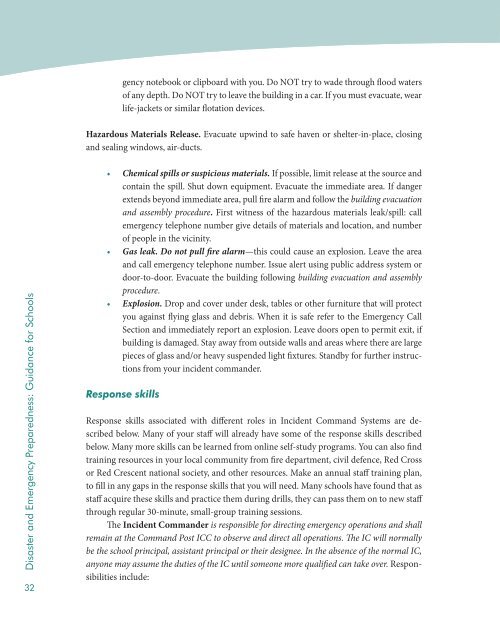Disaster and Emergency Preparedness: Guidance for ... - INEE Toolkit
Disaster and Emergency Preparedness: Guidance for ... - INEE Toolkit
Disaster and Emergency Preparedness: Guidance for ... - INEE Toolkit
You also want an ePaper? Increase the reach of your titles
YUMPU automatically turns print PDFs into web optimized ePapers that Google loves.
gency notebook or clipboard with you. Do NOT try to wade through flood watersof any depth. Do NOT try to leave the building in a car. If you must evacuate, wearlife-jackets or similar flotation devices.Hazardous Materials Release. Evacuate upwind to safe haven or shelter-in-place, closing<strong>and</strong> sealing windows, air-ducts.<strong>Disaster</strong> <strong>and</strong> <strong>Emergency</strong> <strong>Preparedness</strong>: <strong>Guidance</strong> <strong>for</strong> Schools32Chemical spills or suspicious materials. If possible, limit release at the source <strong>and</strong>contain the spill. Shut down equipment. Evacuate the immediate area. If dangerextends beyond immediate area, pull fire alarm <strong>and</strong> follow the building evacuation<strong>and</strong> assembly procedure. First witness of the hazardous materials leak/spill: callemergency telephone number give details of materials <strong>and</strong> location, <strong>and</strong> numberof people in the vicinity.Gas leak. Do not pull fire alarm—this could cause an explosion. Leave the area<strong>and</strong> call emergency telephone number. Issue alert using public address system ordoor-to-door. Evacuate the building following building evacuation <strong>and</strong> assemblyprocedure.Explosion. Drop <strong>and</strong> cover under desk, tables or other furniture that will protectyou against flying glass <strong>and</strong> debris. When it is safe refer to the <strong>Emergency</strong> CallSection <strong>and</strong> immediately report an explosion. Leave doors open to permit exit, ifbuilding is damaged. Stay away from outside walls <strong>and</strong> areas where there are largepieces of glass <strong>and</strong>/or heavy suspended light fixtures. St<strong>and</strong>by <strong>for</strong> further instructionsfrom your incident comm<strong>and</strong>er.Response skillsResponse skills associated with different roles in Incident Comm<strong>and</strong> Systems are describedbelow. Many of your staff will already have some of the response skills describedbelow. Many more skills can be learned from online self-study programs. You can also findtraining resources in your local community from fire department, civil defence, Red Crossor Red Crescent national society, <strong>and</strong> other resources. Make an annual staff training plan,to fill in any gaps in the response skills that you will need. Many schools have found that asstaff acquire these skills <strong>and</strong> practice them during drills, they can pass them on to new staffthrough regular 30-minute, small-group training sessions.The Incident Comm<strong>and</strong>er is responsible <strong>for</strong> directing emergency operations <strong>and</strong> shallremain at the Comm<strong>and</strong> Post ICC to observe <strong>and</strong> direct all operations. The IC will normallybe the school principal, assistant principal or their designee. In the absence of the normal IC,anyone may assume the duties of the IC until someone more qualified can take over. Responsibilitiesinclude:
















